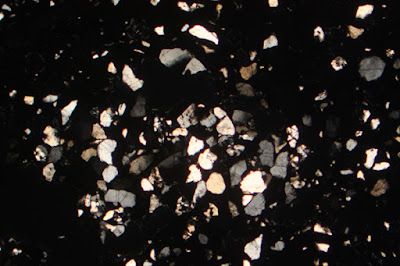At the end of an afternoon spent in Sheffield, on the last day of March in 2021 - when my main objective was to acquire a sample of Silkstone Rock - I posted a selection of some of my more interesting photographs on Facebook.
 |
| Crozzle used for decorative purposes on a boundary wall |
One of these was a photo of crozzle, the black lava like slag that was produced during the now obsolete process of making steel in a cementation furnace and, when Alessandro Da Mommio said he would love to see it under the microscope, I decided to take another trip to Sheffield and obtain a couple of pieces for him.
 |
| Samples of crozzle |
When researching definitions of minerals for my Language of Stone Blog, I had often made a link to his Alex Streckeisen website, which I think provide very clear definitions of various rocks and minerals, accompanied by his excellent photomicrographs.
 |
| The cementation furnace in Sheffield |
The cementation process essentially involved alternate layers of wrought iron and ground charcoal being packed into a stone chest, sealed from the air with wheelswarf and then a fire lit to gradually bring it to red heat - with the load then left at that temperature for 7 to 10 days.
 |
| An information panel at the cementation furnace in Sheffield |
Having obtained a couple more samples of crozzle from City Road, I selected both black and grey samples and, having carefully packaged them to minimise postage costs and jumped through hoops because of BREXIT, I sent them off to Alessandro in Italy.
 |
| Samples of crozzle |
The black crozzle is black and very dense, often with glassy surfaces, but there are no obvious inclusions of material of a different character. The grey crozzle that I collected, however, is much less dense and contains irregularly shaped inclusions of a soft white material that scratches very easily with a fingernail.
 |
| A view of crozzle in plane polarized light by Alessandro Da Mommio |
I know very little about any of the processes for making steel, or the chemistry of slag, but having made a thin section of the black crozzle and examined it with a petrological microscope, Alex informed me that “it is a bit boring in the sense that it only contains silica, glass and bubbles".
 |
| A view of crozzle with crossed polars by Alessandro Da Mommio |
Having myself been very interested in examining a wide variety of rocks under a microscope, as a geology undergraduate, and more recently when producing my own Glowing Edges Designs – based on the kaleidoscope of colours very often seen when using crossed polars – I fully appreciate his comments.
 |
| A view of olivines with crossed polars by Glowing Edges Designs |
As seen in nature as quartz, silica appears as a very dull mineral with very little aesthetic merit – viewed with both plane polarised light and crossed polars – and glassy material, for example in volcanic obsidian, virtually disappears from view.
 |
| A view of crozzle in plane polarized light by Alessandro Da Mommio |
Not having access to a petrological microscope myself and with Alex being very pleased to add such an unusual building material to his collection of thin sections, I consider this to be a great example of post-BREXIT Anglo-Italian collaboration - which will be continued with a piece of coal from Charlton Brook in Sheffield.


No comments:
Post a Comment